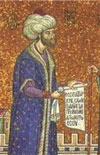| |

|
|

 Sultan Mehmed the Conqueror, started the process of rebuilding in Istanbul after the conquest of Constantinople. Fatih Sultan Mehmed, rearranged the city without damaging the fabric of Istanbul with his unique knowledge upon western culture.
Sultan Mehmed the Conqueror, started the process of rebuilding in Istanbul after the conquest of Constantinople. Fatih Sultan Mehmed, rearranged the city without damaging the fabric of Istanbul with his unique knowledge upon western culture.
According to the Halil İnalcıks Rebuilding of Istanbul By Fatih article, Sultan II. Mehmeds priority was reconstruction of Constantinople: During the whole of his reign the Conqueror's preoccupation was to make Istanbul a true metropolis of his empire written in Halil İnalcıks Rebuilding of Istanbul By Fatiharticle. According to the article some of the developments after the conquest are: Before the Conquest, Istanbul was but a dead city. Mehmed the Conqueror strove with great energ'y to make it again into the political and economic eentre of an empire; to this end he took measllres for the speedy repeopling of the City, as well as for its reconstuction...
Before Istanbul's conquest by the Ottoman Turks, contemporary writers (e.g. Clavijo) pointed out the ruinous state of Ayasofya. The very first act of the Congueror was to have the famous temple restored. To its repair and to the salaries of those employed in it he allocated extensive pious foundations...
Following in the footsteps of the Sultan, the vizirs and notables created by way of pious foundations establishments in section after section of the City, and these in turn developed into new districts, contributing to a rapid extension and repopulation of the City. These establishments generally included, as in the case of the Mahmud Pasha Foundations, a mosque, a medrese and an imaret, to which were added caravanserais and shops. The Mahmud Pasa Bazaar, composed of 260 shops, had expanded into one of the liveliest trading centres of the whole City. The Mahmud Paga Complex was completed in 1462. Thus Istanbul, in the Congueror's very lifetime, became covered with palaces, hostels, caravanserais, bazaars, hans, baths, colleges and assumed the aspect of a flourishing, active Turkish city.
|
|




